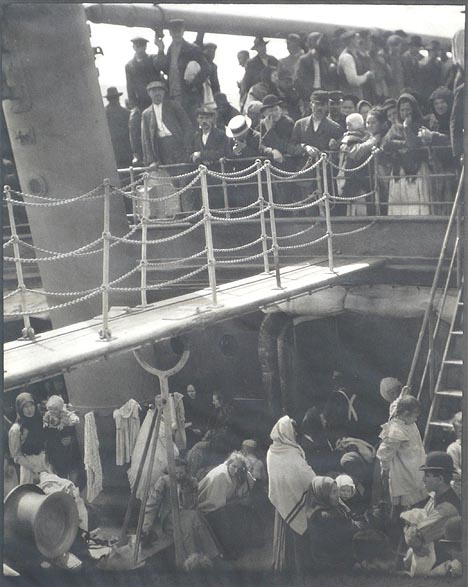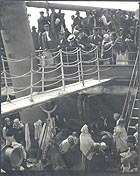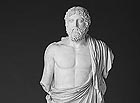
translated and summarized by: Liz Wollner-Grandville,
English summary January 26 - 31
MAK – Applied Arts/Contemporary Art: Artists in Focus #5 Heimo Zobernig: Total Design
Lacquer gone
The MAK presents works, which are part of its contemporary collection, on the top floor of the museum. The space itself is, to put it mildly, “awkward”. Artists are left with no choice other than to explicitly utilize the available space. Heimo Zobernig utilized the space by covering the room-dominating staircase with a scaffold enveloped in stage gaze. A video, which he produced 10 years ago on the occasion of an exhibition opening in a villa, is projected onto the backdrop. With the help of double exposure and Blue-Box technology the interior as well as the exterior of the room are blurred, people are wandering around, the sun sets, everything seems to float; an unusually romantic scenery by the master of coolness.
Apart from that: press board shelves which Zobernig presents with no lacquer whatsoever and thereby reduces them to their barren base frame. Remains of life are found on the surface of the bar; fixed up with glass corners and handprints. Among Zobernig’s most exciting objects is a Kolo Moser closet, at one time reconstructed by himself, at another by a prisoner and by a carpenter. Among his most recent works is a Billy-shelf, decorated with a few mirrors and added to the exhibit. One can view this as an example of a consequent artistic gesture, or simply as boring. All in all, the exhibition is a balanced and worthwhile show, offering a commendable cross-section of Zobernig’s works.
by Nina Schedlmayer
MAK-Applied Arts/Contemporary Art
1010 Vienna, Stubenring 5, until 29. 03.09
www.mak.at
Galerie Johannes Faber: Masterpieces of Photography 1850 – 1970
Too good to be sold
Johannes Faber shows an outstanding and dignified cross-section of his gallery program at his new premises in Vienna’s downtown Dorotheergasse; a museum would be proud to call these works their own. Ranging from Stieglitz’ best known “The Steerage” (1907), emphatically depicting everyday life on an overcrowded ship deck, to a photogram by Lazlo Moholy-Nagy, the onlooker can indulge into everything that was ever generated by classic modern photography. Too bad though, that a photo by Helmut Newton showing women as Barbie dolls is also among the works, while at the same time Frantisek Drtikol so clearly spotlights that act photography has nothing to do with “becoming an object”. This beautiful vintage (1922) depicts a character and not an object of desire, thereby sharply contrasting Newton’s 1981 creation. The only things to criticize at this exhibit are this outlier, as well as the fact that there is not enough information on the works shown. And of course the thought, that these works are much too good to possibly end up in a private collection. After all – some of the displayed works are the last existing originals, as the head of the gallery, Katharina Rosenstingl, pointed out.
Despite the fact that Vienna has two renowned locations dealing with photography: “Westlicht” and the Albertina photography collection, a large institution dealing independently and exclusively with this medium is still missing. Frankly, the public’s negligence is to blame that a gallery has to take on the role of a museum. Anyway - until a photography museum opens its gates in Vienna, if it ever will, it is highly recommendable to visit the Gallery Faber at its new downtown location.
by Wolfgang Pichler
Galerie Johannes Faber
1010 Vienna, Dorotheergasse 12, until 21.02.09
www.jmcfaber.at
Kunstmuseum Bern: Ego Documents – The Autobiographical in Contemporary Art
Constructions of the ego
A stream of water is cutting its way through heaps of stuff, all of which turns out to be the entire content of Isabelle Krieg’s studio in Fribourg. Her curriculum is flowing through the exhibition “Ego Documents” at the Kunstmuseum Bern, and stages the artistic existence as a relationship to objects as well as a poetic liberation: after this exhibit is over, Krieg is contemplating to quasi begin anew in her now empty studio after this ballast has been shed.
The exhibition “Ego Documents – The Autobiographical in Contemporary Art” is the debut of the Berner Kunstmuesum’s new curator, the 40-year old Kathleen Bühler. This complex eclectic show presents constructions of the self, created by 21 artists and offering numerous highlights. Unfortunately, classic Swiss positions including Manon’s or Urs Lüthi’s role-plays were left out. And it is incomprehensible why no reference is made to the James Lee Byars’ exhibit, which is taking place at the same time.
Supported by the Stiftung GegenwART, the Austrian artist Elke Krystufek is the artist in residence. Her colourful statements in wild painted letters sprawl far beyond the boundaries of the space allocated to her. They do not halt before Louis Bourgeois’ and Martin Kippenberger’s works, and not even before those in the neighbouring room, where she even amends On Kawara’s depersonalized “date paintings” with the words “too late”. At first, Krystufek’s trashy aesthetics come across like impious scribbling, but in the end they are also a challenge to the conditions stipulated by the institution museum, and the drawing up of a border by a curator. White overpainting is proof of the artist’s subsequent censorship, offering more than topics to discuss regarding the constraints as well as the freedom of artists in the art system. Yet the placid Berne keeps silent: maybe due to ignorance, possibly due to tolerance.
by Sylvia Mutti
Kunstmuseum Bern
3000 Bern, Hodlerstrasse 12, until 15.02.09
www.kunstmuseumbern.ch
Museo Nacional del Prado: Esculturas del Albertinum – Sculptures from the Dresden Albertinum
Between deities and humans
After the Roman collections Chigi and Albani were purchased for the Elector of Saxony August the Strong, the Dresden Albertinum owned one of the world-renowned collections of antique sculptures outside of Italy. King Philipp V of Spain bought a significant amount of sculptures originating from the same eras from Queen Christina of Sweden for the royal collections in Madrid.
The Prado owns one of the most significant sculpture collections in the world – a fact that is oftentimes forgotten given the museum’s world-renowned paintings. With this exhibit, the Prado is showing three things: part of its own collection with 20 examples ranging from Greek classic to late antiquity Roman art, the sculptures of the Dresden Albertinum, which is currently closed for renovation and sent 46 of its works to a foreign country for the first time, and the dialogue of these two monumental milestones of sculptures, united for the first time in 300 years.
For the first time the statues of Zeus and Phidius’ Lemnian Athena stand side by side with Prado’s monumental Demeter sculpture. The exhibit is divided into three parts; each part being symbolized by a different colour of the museum’s walls.
The light blue rooms symbolize beauty and rationality – showing Roman replicas of the Greek classic. The second part, symbolized by green walls, celebrates the Hellenistic era under Dionysus, the god of wine and ecstasy. The third part, in dark blue, is dedicated to Roman portraits dating from the end of the Imperial era, including the first public presentation of the 15 kilogram silver discus (Missorium de Teodosio) from the Royal Academy of History in Madrid.
The statues of the tall Herculaneum Women are larger than life; the delightful small polychrome terracotta figures of three women, and the Roman replica of a contemplative muse, hair tied together in a pony tail, dating back to the first century A.D. : all as modern, as if time seemed to hang suspended.
by Clementine Kügler
Museo Nacional del Prado
28014 Madrid, Paseo Prado, until 12. 04. 09
www.museoprado.mcu.es
Mehr Texte von translated and summarized by: Liz Wollner-Grandville


 Teilen
Teilen




